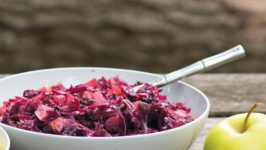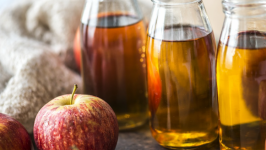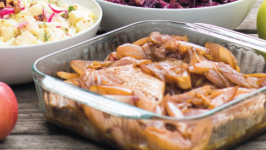On Hunting for Wild Apples
In a not-so-distant past, before most of us were buying all of our food at the grocery store, every autumn found people from all walks of life out collecting feral, or wild, apples. Whether for cider or for cooking and eating, feral apple trees have nourished people for a very long time. Overlooked and ignored while time—sometimes generations— passes them by, these trees often bear truly one-of-a kind apples that are available to anyone with the desire to seek them out and harvest.
The terms “wild” or “feral,” when applied to apples, simply mean any apple tree that has escaped cultivation. This is sometimes the result of a seed sprouting. While apple trees in orchards are clones—built by splicing the twigs from one variety onto the roots of another—apple trees from seeds are genetically unique because each grows from a different seed. Many people today parrot the idea that apple trees should never be planted from seeds, but what they fail to realize is that some of the most amazing cultivars we have today originated as what are called chance seedlings. For example, the famed Granny Smith apple had its origin in a chance seedling found in Australia in the late 1800s.
The modern domesticated apple (Malus domestica) originated in the wild apple trees (Malus sieversii) of what is now southeastern Kazakhstan, in the Tian Shan mountains. Apple trees display what is known to botanists as “extreme heterozygosity,” meaning the offspring they create vary so much that an orchard planted exclusively from, say, Pink Lady seeds might well not have a single tree in it with an apple that looks or tastes like a Pink Lady. What you would find instead would be thousands of different variations, like small and bitter or soft and purplish-red. And the trees themselves would vary in size as well. This genetic variation has led apple trees to be taken all over the world. And wherever there are cultivated apple trees, there are feral apple trees nearby.
The variation in size and flavor of these fruits means that when on the hunt you will probably have to taste-test quite a lot. On any given afternoon while out picking apples I might eat as many as eight apples. I will not lie, many of these do not taste very good. But the trees I find that are great make up for the ones that are not. Our family exclusively picks from old abandoned (orchard) apple trees and wild apple trees. Over the years we have learned which trees make the best apples and we revisit those trees every other year. We go every other year because apple trees are naturally alternate bearing trees, meaning they only produce fruit regularly every other year or occasionally on the third year. That might not sound ideal for harvesting apples every fall, but remember that there are thousands of feral apple trees in Michigan, and they do not synchronize with each other in putting out a crop.
While the very word “feral” might imply a negative reputation, I would urge you to put aside your preconceived notions of bad flavors or bugs in wild apples. These trees are not sprayed with insecticides, fungicides or herbicides and that fact should make you happy. A tree that is left on its own to defend against a disease or infestation produces many more healthful phytochemicals than does a mono-crop of clones that are sprayed to protect their fruit. Bugs in wild fruit is a common thing, but at least with apples it is really obvious and there is clear evidence of the invader. Most other fruits show no signs of worms. In our household we solve the problem of wormy apples by simply cutting off the bad parts and sacrificing them to the compost gods.
Many of the apples that we harvest in the fall are so pretty they could pass for store-bought produce. Just because a tree was not sprayed in no way means that the fruit is worthless. On the contrary, I believe wild apples are far more healthful than their cultivated brothers and sisters. These trees have to fend for themselves against insects, diseases and even rabbits that can eat all of the bark off of a tree in the winter months.
These trees have a resilience that most orchard trees lack.
I would be remiss if I did not mention that most trees planted by American settlers were planted from seeds, and that is because, buggy or not, apples of all shapes, sizes and tastes can be turned into apple cider—once the most popular alcoholic beverage in the country. The beauty of cider is that it can make use of otherwise ugly fruits that most eaters would decline. Besides using up fruit that would otherwise rot, making your own cider is a way you can move your own dial toward self-sufficiency and living locally, a cause that I believe many people could get behind. And fermented cider, when consumed in moderation, is yet another way to take in the healthful polyphenols and antioxidants of the apple.
And yes, apples boast some impressive health benefits. Eating just one medium fresh apple with the skin, seeds and flesh provides you with up to 100 million beneficial microbes, 16 percent of your daily fiber needs, 11 percent of your vitamin C and a host of phytonutrients and antioxidants that include anthocyanins and flavanols. Not to mention that eating apples helps with the regulation of blood sugar, can decrease blood levels of oxidized LDL cholesterol and there is some research showing that eating apples daily can lower your risk of colon cancer.
Knowing the benefits of apples and that feral apples are free for the taking, we should all take strides to eat more of these forgotten fruits. I have been all over Michigan in the autumn months, and I have seen and picked feral apples everywhere I’ve been. I have picked apples outside of Detroit in September, and in the Upper Peninsula in October. I always keep some kind of container in my car during the autumn months, because inevitably I will encounter some tree loaded with delicious fruit to harvest. If the trees are on private land, I always pay a visit to the door to secure picking rights. Rarely if ever do people say no. Usually I get surprise that I would want to pick their apples. Most people assure me that the apples are too wormy to eat, but say that I can take the risk if I desire. The kindness of strangers is always such an appreciated addition to the cool fresh air of the fall.
We harvest hundreds of pounds of these abandoned apples every fall in our household, and this usually requires some sort of plan for how to handle them. First, the worst-looking apples get the bad parts cut off and are sent right to the dehydrator. These dried apples are a wintertime staple in the lunch bags of our children and a constant companion on road trips. Next are the apples that are going to be made into applesauce. These apples should be fairly decent looking, but they do not need to be perfect. Apples at the next step are the keepers, the ones kept for fresh eating. With enough vigilance and care one can keep feral apples until February in a root cellar or basement. To keep apples this long you must have a weekly or twice weekly cull. This step ensures that the bad apples are removed. And by removed I mean eaten straightaway.
Eating locally can be something that you strive for little by little, and adding into the mix something as easy to identify as feral apples can be a very comfortable step to take. With every meal of these delicious fruits you can reminisce about the cool air, colorful leaves and cozy sweatshirts of autumn. It is truly a magical time of the year, and I am sure that it would not be near as good if we weren’t blessed to have such amazing apples to help us through it.








